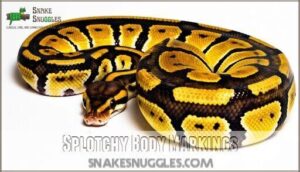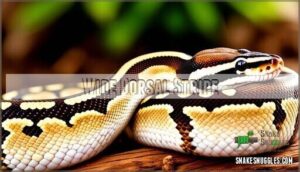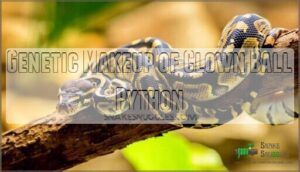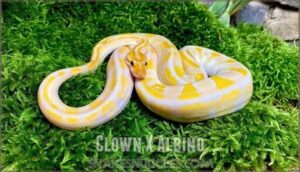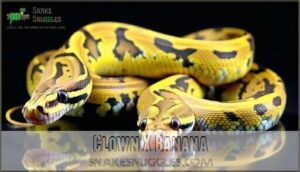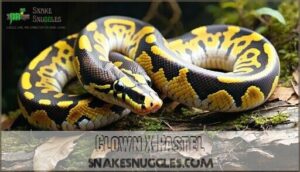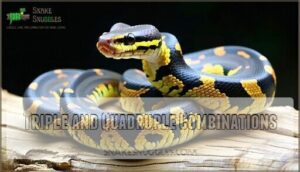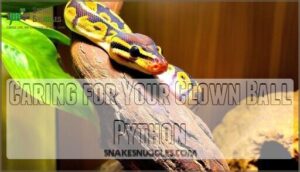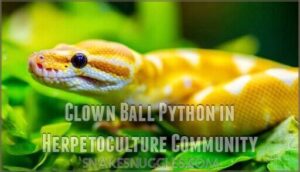This site is supported by our readers. We may earn a commission, at no cost to you, if you purchase through links.
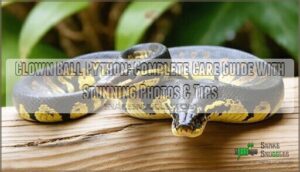
Discovered by Dave and Tracy Barker in 1996, this recessive morph creates a dramatically reduced pattern with wide dorsal striping and an unmistakably mottled head that’s earned its playful name.
The clown gene affects melanin production during development, resulting in lighter base colors and unique teardrop-like markings that fade from black to pale yellow-brown with age.
Unlike some morphs, clowns don’t carry the wobble gene, making them healthy breeding choices.
Current market prices range from $200-400, though premium combinations can reach thousands, revealing fascinating insights about reptilian development and the genetic mechanics behind their striking appearance.
Table Of Contents
- Key Takeaways
- Origins and Discovery of Clown Ball Python Morph
- Distinctive Features of Clown Ball Python
- Genetic Makeup of Clown Ball Python
- Popular Clown Ball Python Morph Combinations
- Caring for Your Clown Ball Python
- Health Considerations for Clown Ball Pythons
- Finding and Purchasing a Clown Ball Python
- Breeding Clown Ball Pythons
- Evolution of Clown Ball Python Market
- Clown Ball Python in Herpetoculture Community
- Frequently Asked Questions (FAQs)
- How big do clown ball pythons get?
- Are clown ball pythons hard to care for?
- How to identify wookie ball in python?
- What does clown mean in ball pythons?
- What does clown gene do?
- Do clown ball pythons have wobble?
- How does parthenogenesis affect clown ball pythons?
- What is the average size of a clown ball python?
- How often do clown ball pythons breed annually?
- Are clown ball pythons prone to aggressive behavior?
- Conclusion
Key Takeaways
- You’ll get a healthy, wobble-free morph – Unlike spider morphs, clown ball pythons do not carry neurological issues, making them an ethical breeding choice with the same care requirements as regular ball pythons.
- You’re investing in a recessive genetic masterpiece – Both parents must carry the clown gene to produce visual offspring, creating distinctive wide dorsal stripes and mottled head patterns that make each snake uniquely identifiable.
- You can expect dramatic color changes over time – Your juvenile’s vibrant yellows and browns will gradually fade to more muted tones around two years old, with dark pigments lightening while base colors may deepen or fade completely.
- You’ll pay $200-400 for quality specimens – While original clowns cost $30,000+ in the late ’90s, today’s market offers accessible pricing for single-gene morphs, though premium multi-gene combinations can still reach thousands.
Origins and Discovery of Clown Ball Python Morph
The clown ball python morph emerged from a remarkable 1996 discovery when Dave and Tracy Barker identified a wild-caught African ball python displaying unusual head coloration and distinctive dorsal banding patterns.
This single snake’s unique genetic makeup would revolutionize the ball python breeding industry, introducing breeders to one of the most sought-after recessive morphs in herpetoculture today, with a significant impact on the breeding industry, and making it a highly recessive morph.
One wild-caught African snake would forever change the face of ball python breeding
Dave and Tracy Barker’s 1996 Discovery
In the sphere of ball python morphs, Dave and Tracy Barker’s 1996 Discovery Story stands as a pivotal moment in reptile Breeding History.
A single wild-caught African specimen forever changed the course of ball python breeding history
The couple encountered a wild-caught African specimen displaying an unusual tear-shaped facial marking and distinctive wide dorsal banding—traits that would revolutionize Snake Genetics.
This original clown ball python exhibited remarkable phenotypic characteristics, with its black pattern elements gradually fading to pale yellow-brown through maturation.
The Barker Method of careful observation and documentation helped confirm this was no ordinary genetic mutation.
Their methodical approach to identifying the recessive gene responsible for this unique phenotype laid the groundwork for Morph Creation techniques still used today.
This single snake became the foundation for an entire lineage of designer morphs.
Initial Breeding Experiments
Following the Barkers’ groundbreaking discovery, Breeding Techniques became experimental territory.
Early breeders conducted Breeding Experiments using Breeder Selection methods, pairing normal-appearing snakes hoping to reproduce the Clown Ball Python trait.
These Ball Python Morphs required extensive Genetic Testing to understand inheritance patterns.
Experiment Outcomes varied wildly—some clutches produced zero clowns, others yielded surprises.
Morph Development progressed slowly as breeders learned this Recessive Gene demanded specific pairings.
Genetic Diversity studies helped refine breeding strategies, transforming random attempts into calculated science.
Confirmation of Recessive Trait
Genetic testing initially revealed the clown ball python’s recessive trait through careful breeding experiments.
Researchers discovered that clown offspring only appeared when both parents carried the recessive gene, confirming the inheritance patterns weren’t linked to dominant traits.
The confirmation process involved analyzing:
- Gene interaction between parent specimens and offspring phenotypes
- Trait expression variations across multiple breeding generations
- Genetic mutation markers specific to the clown ball python morph
- Inheritance patterns comparing recessive versus dominant ball python morphs
This breakthrough helped breeders understand why some crosses produced normal-looking snakes that secretly carried clown genetics.
Rise in Popularity Among Breeders
Within three years of the Barkers’ discovery, clown ball python morphs became the hottest commodity in python breeding circles.
Reptile breeders couldn’t get enough of these unique patterns, driving unprecedented market demand across breeder networks. The morph’s recessive genetics sparked serious genetic research, helping breeders understand inheritance patterns better.
Popularity factors included the clown’s distinctive teardrop markings and wide dorsal stripes that set them apart from standard ball python morphs. This breeding trend transformed ball python habitat discussions at reptile expos nationwide.
| Year | Average Price | Market Status |
|---|---|---|
| 1997 | $2,000+ | Extremely Rare |
| 1999 | $800-1,200 | Limited Supply |
| 2001 | $400-600 | Growing Availability |
Distinctive Features of Clown Ball Python
When you first see a clown ball python, you’ll notice its most striking feature: the distinctive teardrop-shaped markings that create an almost mask-like pattern across its head.
This unique morph displays a wide dorsal stripe running down its back, accompanied by irregular splotchy markings that give each snake its own puzzle-piece appearance.
Mottled Head Pattern
The artistry of a clown ball python’s head coloration resembles nature’s own abstract painting, where genetic mutation creates stunning facial markings unlike any other ball python morphs.
This recessive gene produces distinctive characteristics that make identification straightforward:
- Irregular spotting patterns that vary dramatically between individual snakes
- Teardrop-shaped markings around the eyes and temporal regions
- Mottled pigmentation creating a mosaic effect across the entire head
These facial markings result from altered morph expression during embryonic development, affecting how melanin distributes across cranial scales. The dorsal stripe gene doesn’t influence head patterns, making each clown’s facial features uniquely identifiable for proper snake camouflage adaptation.
Splotchy Body Markings
Beyond the striking head pattern, you’ll discover the clown ball python’s body showcases distinctive splotchy markings that create a jigsaw puzzle effect.
These irregular patches demonstrate remarkable pattern variance across individual specimens. The clown gene reduces melanin production, resulting in enhanced color distribution against cleaner white backgrounds.
Each snake displays unique marking density and spot morphology, making pattern variations highly sought after among ball python morphs enthusiasts. This genetic diversity guarantees no two clown ball pythons share identical color variations or scale texture patterns, due to the clown gene and its impact on melanin production, resulting in a unique color distribution.
Wide Dorsal Stripe
This striking dorsal stripe defines the clown ball python’s most recognizable feature.
The wide, dark band stretches from head to tail like nature’s racing stripe, creating stunning color variations that set these snake morphs apart.
This dominant dorsal marking results from the recessive gene affecting stripe patterns during development.
Unlike typical ball python morphs, the clown’s genetic traits produce this continuous highway of pigmentation that makes identification straightforward for enthusiasts studying ball python genetics.
Color Changes With Age
Your Clown Ball Python’s appearance transforms dramatically as it matures.
Most juveniles display vibrant yellows and rich browns that gradually shift toward more muted tones through Pattern Maturation.
This Color Shift process typically begins around two years of age, when Hue Intensity peaks before Age Related Fading sets in.
The Morph Development follows predictable patterns within ball python morphs.
Dark pigments often lighten while base colors may deepen or fade completely.
Your snake’s unique color variations depend on its specific genetic diversity – some Clowns retain bold contrast throughout life, while others develop subtle pastels.
Pattern variations also evolve substantially.
Those distinctive head markings might soften or spread, and body patterns can merge or separate as scales stretch with growth.
Understanding color genetics helps predict these changes, though each individual snake surprises owners with its personal timeline.
Don’t worry if your vibrant juvenile becomes a gentle-toned adult – it’s perfectly normal snake aging.
Genetic Makeup of Clown Ball Python
Understanding clown ball python genetics starts with recognizing that the clown trait follows recessive inheritance patterns, meaning both parents must carry the gene for offspring to display the morph.
This recessive gene affects melanin production and pattern formation during embryonic development, creating the distinctive wide dorsal stripe and mottled markings that set clowns apart from other ball python morphs, which is a result of the recessive inheritance patterns.
Recessive Gene Inheritance
Understanding recessive gene inheritance in your clown ball python is like solving a genetic puzzle. The clown ball python‘s stunning appearance results from recessive alleles that follow specific heredity rules. Both parents must carry the genetic mutation for offspring to display these genetic traits.
Here’s how gene expression works in ball python morphs:
- Inheritance patterns require two copies of the recessive gene
- Heterozygous carriers look normal but pass the trait
- Breeding two carriers yields 25% visual clowns
- Recessive gene inheritance creates predictable genetic outcomes
- Testing confirms hidden genetic potential in breeding stock
- Multiple generations may pass before traits appear visually
This genetic mutation makes clown morphs particularly valuable in breeding programs. Mastering genetic variations is essential for successful ball python breeding.
Melanin Production Reduction
Within your clown ball python’s cells, melanin production takes a fascinating detour.
Unlike axanthic morphs that block specific pigments, the clown’s recessive gene reduces overall melanin levels without complete elimination.
This gene expression creates lighter base colors and enhanced skin patterns compared to wild-type pythons.
The pigment genetics behind color variation explain why clown morphs display those signature tear-drop markings and dorsal stripes—melanin levels decrease selectively across different body regions.
Pattern Distribution During Embryonic Development
During embryo growth, your clown ball python’s distinctive patterns emerge through precise gene expression control.
Cell formation and tissue development guide melanin production as the recessive gene directs morphogenesis.
This genetic mutation creates pattern distribution variations during early development stages.
Each embryonic clown ball python develops unique markings through complex cellular programming, ensuring no two snakes share identical patterns despite sharing the same genetic blueprint.
Comparison to Albino Genetics
Genetic Contrast between clown and Albino Genetics reveals fascinating differences.
Clown Ball Python carries a Recessive Gene that reduces melanin production, while albino Ball Python Morphs completely eliminate it through Genetic Mutation.
Trait Inheritance patterns differ substantially – clowns retain golden-brown Color Variation and dark eye pigmentation, whereas albinos display yellow-white coloration with red eyes.
Understanding Gene Interaction helps predict Morph Expression outcomes in breeding programs.
Popular Clown Ball Python Morph Combinations
You’ll discover incredible possibilities when you combine the recessive clown gene with other popular ball python morphs.
These designer combinations create unique patterns and colors that showcase the clown’s distinctive wide dorsal stripe alongside complementary genetic traits.
Clown X Albino
When you cross a Clown Ball Python with an albino, you’re creating a double recessive masterpiece that showcases incredible Gene Expression patterns.
This Clown X Albino combination produces stunning Color Variations through altered melanin production.
Here’s what makes this Hybrid Breeding combination special:
- Morph Patterns blend clown’s distinctive dorsal stripe with albino’s vibrant yellows
- Albino Genetics eliminate dark pigments while preserving clown’s unique head markings
- Recessive Gene inheritance requires both parents carrying target alleles
These Ball Python Morphs command premium prices due to their rarity and striking appearance.
Clown X Banana
The Clown X Banana combination creates striking Color Patterns through Banana Genetics mixing with clown morphology.
This Ball Python Morphs pairing produces vibrant yellow-orange hues contrasting beautifully against clown teardrop markings.
Morph Breeding enthusiasts prize these Hybrid Traits for their lavender-tinted eyes and enhanced brightness.
Standard Snake Care requirements apply to Banana Clown specimens, making them accessible for collectors seeking visual impact without specialized husbandry demands like Piebald Ball Pythons require.
Lavender tint
Clown X Pastel
Moving from vibrant banana yellows, you’ll find the Pastel Ball Python brings softer beauty to Clown X Pastel combinations.
This Ball Python Morphs pairing showcases incredible Pattern Inheritance where Pastel Genetics lighten the clown’s dramatic markings.
The Recessive Gene from clowns creates striking Morph Variations when combined with pastel’s co-dominant traits.
Hybrid Breeding produces snakes with faded yellows, reduced pattern contrast, and enhanced Color Morphs that make each Clown Ball Python specimen uniquely enticing for collectors.
Understanding the pastel ball python genetics is vital for successful breeding outcomes.
Clown X Piebald
When you combine Clown Ball Python genetics with Piebald Ball Python traits, you’re creating something truly spectacular.
This Clown X Piebald combination showcases stunning Color Variations where the Clown’s distinctive mottled head pattern meets Piebald’s striking white patches, creating breathtaking Hybrid Traits that’ll make your jaw drop.
- Recessive Gene inheritance requires both parents carrying piebald genetics
- Morph Patterns blend clown’s dorsal stripe with piebald’s unpredictable white sections
- Breeding Tips suggest pairing proven genetics for consistent offspring results
- Ball Python Morphs like this command premium prices due to rarity
Triple and Quadruple Combinations
Advanced Triple Morphs and Quad Genetics create breathtaking Color Patterns through complex Gene Interactions.
Your Hybrid Breeding projects with Clown Ball Python combinations reveal stunning visual effects.
These Triple and Quadruple Combinations showcase Ball Python Morphs at their finest, where multiple Recessive Gene expressions enhance Genetic Diversity and produce collector-quality specimens with extraordinary dorsal clarity.
Caring for Your Clown Ball Python
Caring for your clown ball python requires the same foundational husbandry as any Python regius, but understanding their specific needs guarantees these stunning morphs thrive in captivity.
You’ll need to master five key areas: proper enclosure setup, temperature and humidity control, feeding schedules, shedding support, and safe handling techniques.
Optimal Enclosure Setup
Creating the perfect habitat setup for your clown ball python requires attention to three essential elements. Choose an enclosure size of at least 40 gallons for adults, providing adequate space for natural behaviors.
Here are the key habitat setup requirements:
- Substrate options like cypress mulch or aspen shavings for burrowing
- Hiding spots on both warm and cool sides for security
- Water source large enough for soaking but not drowning
Selecting the correct substrate is essential for humidity. Consider suitable bedding options for your ball python. Add enrichment items like branches or fake plants to create a naturalistic environment. Your clown ball python will thrive when these fundamental components work together seamlessly.
Temperature and Humidity Requirements
Your clown ball python thrives with proper heating gradients and humidity control.
Maintain a temperature gradient of 78-88°F with accurate thermostat monitoring. Keep humidity levels at 50-60% using reliable monitoring tools to prevent shedding issues in your ball python care routine.
Essential habitat setup requirements:
- Install dual thermometers – one for warm side, one for cool side temperature accuracy
- Use cypress mulch substrate – naturally maintains proper moisture without mold growth
- Place large water bowl – provides drinking water while boosting ambient humidity levels
- Monitor daily readings – consistent environmental conditions prevent stress and health problems
Feeding Guidelines
Feeding your clown ball python properly requires attention to prey size and feeding frequency.
Offer appropriately sized frozen-thawed rodents heated to 100°F. Juveniles need weekly meals, while adults eat every two weeks.
It’s important to bear in mind consistent feeding supplies for your python.
Don’t panic if your python refuses food—it’s perfectly normal behavior that doesn’t indicate health problems in most cases.
Shedding Assistance
Maintaining ideal humidity levels between 50-60% prevents most shedding problems in your clown ball python.
When stuck sheds occur, you’ll need to provide gentle assistance through these methods:
- Increase enclosure humidity to 70-80% temporarily using proper substrate moisture
- Create a humid hide with damp sphagnum moss for natural shedding assistance
- Provide a rough surface like cork bark for the snake to rub against
Monitor shedding frequency closely – healthy snakes shed every 4-8 weeks depending on age and growth rate. If problems persist despite proper care, seek veterinary assistance promptly.
Handling Techniques
Proper snake handling requires confidence and respect for your ball python’s nature.
Always approach slowly, supporting their body weight with both hands—never grab just the head or tail.
Ball python owners should wait 48 hours after feeding before handling.
Use gentle touch and smooth movements, keeping sessions under 15 minutes.
These safety precautions and support techniques guarantee comfortable interactions while preventing stress and escape prevention.
Health Considerations for Clown Ball Pythons
You’ll be pleased to know that clown ball pythons don’t carry the neurological wobble gene that affects some other morphs like spider ball pythons.
While they’re generally healthy snakes, you should still watch for common ball python issues.
Like respiratory infections, mites, and retained sheds that can affect any Python regius regardless of their genetic makeup, these issues are important to consider for the overall well-being of your pet.
Absence of Wobble Gene
Unlike spider morphs, Clown Ball Python genetics offer Morph Stability without neurological complications.
Gene Expression in clowns doesn’t produce the wobble condition that affects other morphs.
Genetic Testing confirms this Absence of Wobble Gene:
- No neurological disorders
- Stable feeding responses
- Normal locomotion patterns
- Ethical breeding choice
Ball python genetics make clowns ideal for responsible keepers seeking beautiful morphs without genetic conditions.
Potential Inherited Conditions
Clown ball pythons demonstrate remarkable genetic stability compared to other morphs. Research confirms no predisposition to inherited traits like wobble syndrome or congenital defects.
The recessive gene affects melanin production and pattern distribution without causing health risks. Genetic diversity remains strong, with breed predispositions to genetic disorders virtually nonexistent.
However, genetic conditions can emerge in complex combinations. Understanding ball python genetics is essential for breeders to manage these factors effectively.
| Genetic Condition | Clown Morph Risk | Prevention Strategy |
|---|---|---|
| Neurological disorders | None documented | Select healthy breeding stock |
| Fertility issues | No increased risk | Monitor reproductive health |
| Pattern abnormalities | Normal variation | Understand morph genetics |
| Congenital malformations | Baseline population rates | Proper incubation techniques |
Common Health Issues
Ball pythons face several health challenges that require your attention and proactive care. Respiratory infections often develop from improper humidity levels, while parasites can weaken your snake’s immune system substantially.
- Respiratory Issues: Watch for mouth breathing, wheezing, or excess mucus around the nostrils
- Parasite Control: Regular fecal examinations help detect mites, worms, and other internal parasites
- Shedding Problems: Incomplete sheds indicate low humidity or underlying health conditions
- Feeding Disorders: Monitor for regurgitation, refusal to eat, or abnormal feeding behaviors
Importance of Regular Veterinary Check-ups
Regular veterinary checkups aren’t just smart—they’re your clown ball python’s lifeline.
Schedule annual visits with a reptile veterinarian who understands Python regius anatomy and common snake diseases.
These preventive measures catch respiratory infections, parasites, and metabolic issues before they escalate.
While veterinary costs seem steep upfront, preventive care saves money compared to emergency treatments.
Your vet establishes baseline health parameters, tracks growth patterns, and provides species-specific guidance for ideal husbandry.
Finding and Purchasing a Clown Ball Python
You’ll find clown ball pythons (Python regius) through reputable breeders who specialize in morph genetics and can provide detailed lineage information.
Research sellers carefully, as quality specimens with proven genetics typically cost $300-600 for hatchlings, while rare multi-gene combinations can exceed $5,000.
Reputable Breeders and Sellers
Success hinges on finding reputable breeders who prioritize genetics and animal welfare.
Research breeder reviews thoroughly before committing to purchase.
Established reptile breeders often participate in snake auctions and maintain transparent breeding records.
Verify compliance with local reptile laws and pet shipping regulations.
Online marketplaces connect reptile enthusiasts with quality ball python breeders nationwide.
The reptile community values ethical practices, so seek recommendations from experienced collectors who can guide you toward trustworthy sources.
Reputable ball python breeders typically have Ball Python resources available to guarantee the best care for their animals, ensuring a positive experience for both the breeder and the pet owner, by supporting animal welfare and following local regulations.
Reptile Expos and Conventions
Reptile Shows and Expo Events provide hands-on opportunities to examine Python regius clown morphs before purchasing.
These Herp Conventions gather reptile enthusiasts and established breeders in one location.
When attending reptile expos, you’ll discover:
- Live specimen evaluation – Assess dorsal stripe patterns and head markings directly
- Breeder Meetings – Discuss lineage documentation and husbandry practices face-to-face
- Snake Auctions – Competitive bidding on rare clown combinations
- Educational seminars – Learn advanced ball python breeding techniques
- Networking opportunities – Connect with the broader reptile community
These reptile conventions offer unmatched access to quality animals and expert knowledge.
Online Marketplaces for Morphs
Beyond reptile expos and conventions, online marketplaces for morphs offer unparalleled access to clown ball python specimens.
MorphMarket dominates with filtering tools, breeder reviews, and shipping policies. Reptile forums provide community insights, while online auctions create competitive pricing.
| Platform Feature | Benefit |
|---|---|
| Price Tracking | Monitor morph prices historically |
| Seller Ratings | Verify breeder reviews authenticity |
| Photo Verification | Confirm specimen quality pre-purchase |
| Shipping Guarantees | Protect live arrival investments |
These digital platforms revolutionize ball python morphs acquisition, connecting collectors with global breeders efficiently.
Breeding Clown Ball Pythons
Breeding clown ball pythons (Python regius) requires careful selection of compatible morphs to maximize genetic diversity and produce viable offspring with the desired recessive traits.
You’ll need to understand Punnett square calculations and maintain precise incubation conditions at 88-92°F with 90% humidity for approximately 55-60 days to guarantee successful hatching rates.
Selecting Breeding Pairs
When selecting breeding pairs for clown ball pythons, you’ll want to focus on genetic diversity and morph compatibility.
Since clown is a recessive gene, pair two clowns for guaranteed clown offspring, or cross a clown with another morph carrying the recessive gene.
Consider genetic testing to verify lineage and avoid inbreeding.
Evaluate each snake’s health, size, and temperament before committing to selective breeding strategies that prioritize breeder ethics.
Incubation Requirements
Once you’ve prepared your breeding pair, proper incubation requirements become critical for breeding success. Maintain an incubation temperature of 88-89°F with precise temperature gradient control—think of it as creating a reptilian nursery, not a sauna! Humidity control at 100% prevents dangerous dimpling.
Regular egg candling reveals developing embryos throughout the 55-60 day incubation period. Understanding ball python egg incubation is key to a successful hatch.
Essential steps for ideal incubation:
- Monitor temperature religiously—even slight fluctuations can doom your clutch
- Check humidity daily—dry eggs equal heartbreak and failed hatches
- Candle weekly—watching tiny pythons develop brings pure joy
Hatchling Care
After your clown ball python (Python regius) hatchlings emerge, you’ll need to create individual housing setups to prevent competition and stress.
Each baby requires its own enclosure with proper temperature management and humidity control.
| Care Aspect | Specification | Monitoring Frequency | Notes |
|---|---|---|---|
| Temperature Gradient | 78-82°F cool/85-88°F warm | Daily | Use digital thermometers |
| Humidity Control | 55-65% RH | Every 2-3 days | Mist substrate lightly |
| Snake Housing | 20-gallon long minimum | Weekly cleaning | Secure lid essential |
| Hatchling Feeding | Hopper mice every 7 days | Track weight gain | Start 7-10 days post-hatch |
Your ball python care routine should include providing secure hides on both temperature zones.
The feeding schedule begins once they’ve completed their first shed, typically within two weeks.
Handle hatchlings minimally during their first month to reduce stress and allow proper acclimation to their new environment.
Genetic Outcomes and Predictions
Once your hatchlings arrive, predicting their genetic makeup becomes an exciting puzzle. Understanding Trait Inheritance helps you anticipate which offspring will display the coveted Recessive Gene patterns.
Here’s what you can expect from different breeding scenarios:
- Clown × Normal produces 100% heterozygous carriers with standard appearances
- Clown × Clown yields 25% visual clowns, 50% carriers, 25% normals
- Clown × Het Clown creates 50% carriers, 25% visual clowns, 25% normals
- Multi-gene crosses produce complex Breeding Outcomes with varied Gene Expression
- Genetic Lineages influence Pattern Distribution and Melanin Production intensity
Genetic Trends show increasing Genetic Diversity in Morph Predictions.
Evolution of Clown Ball Python Market
Since Dave and Tracy Barker first introduced the clown morph in 1996, you’ve witnessed dramatic shifts in both pricing and availability within the ball python breeding community.
What started as an expensive novelty has evolved into one of the most sought-after base morphs for creating complex designer combinations.
Historical Price Trends
Since the late ’90s, clown ball python prices have ridden a wild financial rollercoaster that’d make Wall Street jealous. These ball python morphs started at eye-watering $30,000+ but crashed to today’s $200-400 range through market saturation.
For those interested in purchasing a clown ball python, to find a healthy pet, research reputable reptile sales online.
Historical price trends reveal fascinating market analysis:
- Price fluctuations from $30,000 (1999) to under $500 (2025)
- Auction results peaked during 2000-2005 breeding boom
- Sales data shows 95% value decline over two decades
- Cost trends stabilized as supply outpaced demand
- Ball python trade shifted focus to rare multi-gene combinations
Current Demand and Availability
Today’s clown ball python market shows explosive demand that far exceeds availability through traditional breeder networks and pet stores.
Online sales platforms and reptile expos and conventions struggle to meet collector interest, with auction prices reflecting this scarcity.
Market trends indicate current demand and availability gaps will persist as ball python morphs gain popularity among enthusiasts seeking these distinctive designer specimens.
Emerging Morph Combinations
Today’s breeders are pushing Clown Ball Python boundaries with exciting new combinations.
These emerging morph patterns showcase incredible genetic diversity through strategic gene mixing:
- Leopard Clown: Enhances pattern clarity and contrast
- Banana Clown: Creates vibrant color variations with golden tones
- Enchi Clown: Amplifies intricate trait expression patterns
These designer morphs demonstrate how hybrid breeding continues expanding possibilities in herpetoculture.
Breeders consider ball python morph market trends when creating new combinations.
Future Predictions for Clown Morphs
Market experts predict clown ball python trends will dominate through 2030, with annual growth rates hitting 7-10%.
You’ll see genetic research advancing pattern predictability while breeding outlook remains strong – premium combinations like Banana Clown reaching $3,500.
Market forecast shows 65% of North American breeders now work with clown genetics.
Color variations continue expanding through quadruple combinations, though genetic diversity concerns emerge. Ball python morphs face potential regulatory challenges, making ethical breeding practices increasingly important for sustainable clown morph futures.
Clown Ball Python in Herpetoculture Community
You’ll find the clown ball python has revolutionized selective breeding practices within the herpetoculture community since its discovery in 1996.
This recessive morph serves as both a prized collector specimen and an educational tool for understanding Python regius genetics.
Impact on Ball Python Breeding
Clown ball pythons revolutionized selective breeding within herpetoculture, creating unprecedented morph development opportunities.
The clown morph sparked innovation in breeding techniques, though responsible breeders now balance market trends with maintaining healthy ball python morphs rather than chasing profits alone.
Breeder networks expanded rapidly as this recessive gene opened doors to countless genetic diversity combinations.
Collector Appeal and Rarity
You’ll find Clown Ball Python specimens commanding premium prices due to their Rare Genetics and striking pattern variations.
These factors contribute to the Collector Value that drives Market Trends within established Breeder Networks.
The demand for specific Ball Python morphs, such as the Killer Clown Ball Python, creates competitive bidding for quality lineages, representing genetic treasures that serious collectors actively pursue through specialized channels.
Educational Value for Genetics Study
Beyond rare beauty lies hands-on learning. Clown ball python genetics teach fundamental Genetic Principles through observable Heredity Patterns. You’ll witness recessive gene inheritance creating predictable outcomes while studying Trait Expression variations.
- Gene Interaction demonstrates how single mutations affect python morphs development
- Molecular Biology concepts become tangible through ball python genetics breeding programs
- Genetic history documentation helps predict future morph combinations and python morphs evolution
Ethical Considerations in Morph Breeding
While studying genetics reveals fascinating patterns, responsible ownership demands we consider the broader picture.
Breeding ethics isn’t just about producing stunning clown ball python morphs—it’s about animal welfare and conservation impact.
You must balance visual appeal with health outcomes, avoiding combinations that compromise quality of life.
| Ethical Factor | Responsible Practice | Impact on Animals |
|---|---|---|
| Animal Welfare | Health screening before breeding | Reduces genetic defects |
| Gene Editing | Avoid harmful trait combinations | Prevents neurological issues |
| Conservation Impact | Support captive-bred lines only | Protects wild populations |
| Responsible Ownership | Educate buyers on care needs | Reduces abandonment rates |
| Breeding Ethics | Document lineage and health | Maintains genetic integrity |
Frequently Asked Questions (FAQs)
How big do clown ball pythons get?
Python regius adults typically reach 3-5 feet in length, with females growing larger than males.
You’ll find clown ball pythons maintain identical size parameters to wild-type specimens, despite their striking recessive genetic modifications.
Are clown ball pythons hard to care for?
No, they’re actually quite manageable!
Clown ball pythons have identical care requirements to regular ball pythons.
Just maintain proper temperature gradients, humidity levels, and provide adequate hiding spots for stress-free keeping.
How to identify wookie ball in python?
Like searching through cosmic dust for hidden treasures, spotting Wookie pythons requires keen observation.
You’ll notice extremely dark brown heads with faint headstamps, bold black bodies with nearly clean dorsals, and golden-hued alien heads with subtle blushing throughout.
What does clown mean in ball pythons?
Clown refers to a recessive genetic morph in ball pythons that creates a distinctive wide dorsal stripe running down the snake’s back.
It also creates a mottled head pattern with irregular spots resembling face paint.
What does clown gene do?
The gene creates a recessive trait that produces a distinctive wide dorsal stripe running down your snake’s spine.
The trait also includes irregular mottled head patterns and splotchy body markings that give each individual a unique appearance.
Do clown ball pythons have wobble?
No, clown ball pythons don’t have wobble syndrome.
You won’t see neurological issues with this morph since it’s a simple recessive gene that doesn’t affect the nervous system like spider morphs do.
How does parthenogenesis affect clown ball pythons?
Before you send your clown ball python into Victorian-era parlor tricks, parthenogenesis doesn’t affect them.
This virgin birth reproduction doesn’t naturally occur in Python regius, requiring male-female breeding for viable offspring production.
What is the average size of a clown ball python?
Adult ball pythons typically reach 3-5 feet in length, with females growing larger than males.
You’ll find most clowns weigh 3-5 pounds when fully grown, making them perfect medium-sized companions for snake enthusiasts.
How often do clown ball pythons breed annually?
Like clockwork in nature’s rhythm, you’ll find breeding typically occurs once annually during cooler months when Python regius naturally experiences reproductive cycles, though captive conditions can influence timing and frequency.
Are clown ball pythons prone to aggressive behavior?
Ball pythons aren’t naturally aggressive snakes. You’ll find clown morphs display the same docile temperament as wild-type ball pythons. They’re actually known for being calm, defensive rather than offensive creatures.
Conclusion
Mastering clown ball python care requires understanding their unique genetics, providing proper husbandry, and appreciating their distinctive beauty.
Your clown ball python will thrive with consistent temperatures, appropriate humidity levels, and regular feeding schedules.
These remarkable reptiles offer both beginner-friendly characteristics and advanced breeding potential for experienced keepers.
Whether you’re drawn to their mottled head patterns or interested in creating stunning morph combinations, the clown ball python represents an excellent choice for any Python regius enthusiast seeking a healthy, visually striking serpent.
- https://home.wellsfargoadvisors.com/Tracy.Barker
- https://terrariumquest.com/ball-python/morphs/
- https://www.morphmarket.com/morphpedia/ball-pythons/pastel/
- https://community.morphmarket.com/t/morph-issues-ball-pythons/114
- https://www.nwreptiles.com/ball-python-genetic-behaviors-and-morph-breeding-oddities/


